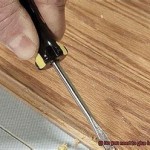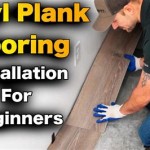How To Get Superglue Off Vinyl Floor
Vinyl flooring, lauded for its durability, affordability, and ease of maintenance, often finds itself in high-traffic areas of the home. Despite its resilience, vinyl is not impervious to damage, and accidental spills, particularly of adhesives like superglue (cyanoacrylate), can pose a significant challenge. Removing superglue from vinyl flooring requires a methodical approach to prevent further damage to the floor's surface. This article provides a comprehensive guide to safely and effectively removing superglue from vinyl surfaces.
Superglue's tenacious bond arises from its ability to polymerize rapidly in the presence of moisture, forming a strong, rigid film. This rapid curing makes immediate action paramount. Delaying action can exacerbate the problem, making removal more difficult and increasing the risk of damaging the vinyl. The success of superglue removal hinges on understanding the adhesive's properties and employing appropriate techniques and solvents.
Immediate Action: Prevention and Initial Steps
The first line of defense against superglue mishaps is prevention. When working with adhesives, take precautionary measures to protect the vinyl floor. Covering the work area with drop cloths or protective sheeting can prevent accidental spills. If a spill does occur, immediate action is crucial.
The very instant superglue makes contact with the vinyl floor, the immediate task is containment. Avoid touching or spreading the spill. If the spill is fresh and relatively small, blotting it up with a clean, absorbent cloth is crucial. Avoid wiping, which will only spread the adhesive and potentially damage the surrounding area. Use a clean section of the cloth each time to prevent re-depositing the glue. Gently pressing the cloth onto the spill will help absorb as much of the wet adhesive as possible.
Once the immediate spill is contained, allow the glue to dry completely. Attempting to remove wet glue will only smear it and make the situation worse. Patience is key at this stage. Once dried, the hardened glue can be addressed with more targeted removal methods. Avoid walking on or placing heavy objects on the spill area while it dries.
Softening the Superglue: Heat and Solvents
The goal of softening superglue is to weaken its bond to the vinyl flooring, facilitating its removal without damaging the floor’s surface. Heat and solvents are two primary methods for achieving this. The choice between heat and solvents depends on various factors, including the size of the spill, the type of vinyl flooring, and personal preference.
Heat, in the form of a hairdryer set on low, can soften the adhesive. Hold the hairdryer a few inches away from the glue spot and direct the warm air onto the glue for a few minutes. Periodically check the glue’s consistency; it should become slightly pliable. Avoid overheating, as excessive heat can damage or discolor the vinyl. Once the glue has softened, gently scrape it away with a plastic scraper or a dull-edged knife. Exercise caution to prevent scratching the vinyl surface. Wipe away any residue with a clean, damp cloth.
Numerous solvents can dissolve or weaken superglue, including acetone (nail polish remover), isopropyl alcohol, and specialized adhesive removers. Always test the solvent in an inconspicuous area of the vinyl floor before applying it to the glue spot to ensure it doesn’t damage or discolor the surface. Apply a small amount of the chosen solvent to a clean cloth and gently dab it onto the glue. Allow the solvent to sit for a few minutes to penetrate and soften the adhesive. After a brief soaking, carefully scrape away the softened glue with a plastic scraper. Repeat the process as needed. After removing the glue, clean the area with soap and water to remove any solvent residue. Always ensure adequate ventilation when working with solvents.
Mechanical Removal: Scraping and Peeling
After softening the superglue with heat or solvents, mechanical removal techniques come into play. Scraping and peeling are effective methods for physically removing the softened adhesive from the vinyl floor. These methods require a delicate touch and the use of appropriate tools to minimize the risk of damage.
Plastic scrapers are ideal tools for removing softened superglue. Their relatively soft material minimizes the risk of scratching the vinyl surface. Hold the scraper at a low angle to the floor and gently work it under the edge of the glue spot. Apply steady, even pressure to lift the glue away from the vinyl. Avoid using excessive force, which can gouge or scratch the floor. If the glue is particularly stubborn, reapply heat or solvent and allow it to soften further before attempting to scrape again.
In some cases, the softened glue may peel away from the vinyl in small pieces. Use your fingers (protected with gloves) or a pair of tweezers to gently peel away the softened glue. Avoid pulling forcefully, which can damage the vinyl. Work slowly and patiently, taking care to remove all traces of the adhesive. After removing the bulk of the glue, use a clean cloth dampened with a solvent or soapy water to remove any remaining residue.
For particularly thin layers of remaining superglue, a melamine sponge, commonly known as a magic eraser, can be used with caution. Wet the sponge and gently rub it over the remaining glue residue. Test the sponge in an inconspicuous area first, as the abrasive nature of the melamine can dull the finish of some vinyl flooring. Use light pressure and avoid prolonged scrubbing. Rinse the area thoroughly with clean water after using the magic eraser.
Post-Removal Cleaning and Restoration
Once the superglue has been successfully removed, the final step is to clean and restore the affected area of the vinyl floor. This involves removing any lingering residue, restoring the floor's shine, and preventing future damage. Thorough cleaning and maintenance will ensure the vinyl floor looks its best and maintains its durability.
Start by cleaning the area with a mild detergent and warm water. This will remove any remaining solvent residue, loosened glue particles, and general dirt and grime. Use a soft cloth or sponge to gently scrub the area, and then rinse thoroughly with clean water. Ensure the area is completely dry before proceeding.
If the superglue removal process has dulled the finish of the vinyl floor, a vinyl floor polish or restorer can be used to restore its shine. Follow the product instructions carefully, and test it in an inconspicuous area first to ensure compatibility with the flooring. Apply the polish or restorer evenly and allow it to dry completely. Buff the area with a clean, dry cloth to achieve a glossy finish. Regular cleaning and polishing will help maintain the floor's appearance and protect it from future damage.
After cleaning and polishing, inspect the area for any remaining imperfections. If any scratches or minor damage are present, a vinyl floor repair kit can be used to address them. These kits typically contain fillers and color-matching compounds to conceal scratches and restore the floor's original appearance. Follow the kit's instructions carefully for best results. Addressing minor damage promptly will prevent it from worsening over time and help maintain the floor's overall integrity.
Preventative measures are crucial in avoiding future superglue mishaps. When working with adhesives, always protect the vinyl floor with drop cloths or protective sheeting. Store superglue and other adhesives in a safe and secure location, out of reach of children and pets. By taking proactive steps to prevent spills and damage, the vinyl floor can remain pristine and durable for years to come.
Proper ventilation is very important if solvent like acetone or isopropyl alcohol is used for removing superglue. Open windows or use a fan to circulate air and avoid inhaling fumes. Safety should be the number one priority.
Always test any cleaning solution or method in an inconspicuous area first to ensure it does not damage or discolor the vinyl floor. This is especially important for older or more delicate vinyl floors.

How To Remove Vinyl Glue From The Floor Effective Cleanup Guide Waste Removal Usa

Floor Glue Clean Howto Luxuryvinylplank Pvc Tiktok

Removing Glue From Vinyl Plank Flooring Hometalk

How To Remove Vinyl Glue From The Floor Effective Cleanup Guide Waste Removal Usa

How To Remove Vinyl Glue From The Floor Effective Cleanup Guide Waste Removal Usa

How To Remove Glue Residue From Vinyl Flooring

Removing Adhesive From Your Vinyl Flooring Repair Tiktok

Don T Panic If You Spill Super Glue On Wood Floors Here S A Simple Solution

Avoid Costly Mistakes Repairing Vinyl Plank Flooring Made Easy

Remove Super Glue From Hardwood Flooring
Related Posts








